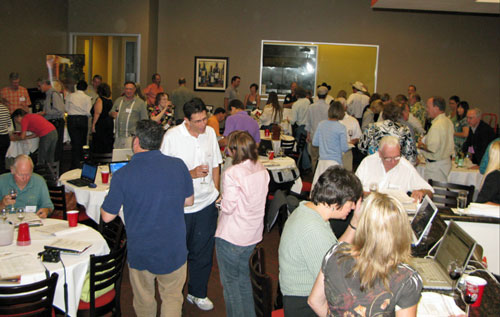
Ten Things We Learned at #DLW09 Conference & Taste-Off and #Texsom
Last weekend I attended the GO TEXAN DrinkLocalWine.com Conference (www.drinklocalwine.com) and Twitter Taste-Off (https://vintagetexas.com/?p=1083) and the Texas Sommelier Conference (www.texsom.com) in Dallas Texas. As my previous blog posts have indicated, it was a wild ride. It was hot Texas summer sun outside, but cool refreshing wines inside at both events.
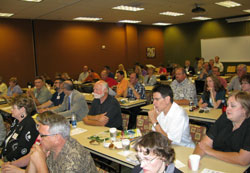 Even though I was in charge of the Texas Twitter Taste-Off event, I was able still to rattle off around one hundred comments on Twitter from Friday through Sunday morning. You can search the hashtags #DLW09 and #Texsom for all the raw Twitter feed from the all the attendees. Interestingly enough, Twitter became my default notebook for the weekend with contributions from my PC (via TweetDeck – http://tweetdeck.com/beta) during the conference and taste-off, and from by phone during Texsom.
Even though I was in charge of the Texas Twitter Taste-Off event, I was able still to rattle off around one hundred comments on Twitter from Friday through Sunday morning. You can search the hashtags #DLW09 and #Texsom for all the raw Twitter feed from the all the attendees. Interestingly enough, Twitter became my default notebook for the weekend with contributions from my PC (via TweetDeck – http://tweetdeck.com/beta) during the conference and taste-off, and from by phone during Texsom.
What I Learned – Twitter and Blogs ROCK!
I reviewed my tweets first by viewing them on TweetDeck and then also by searching the two abovementioned hashtags at www.search.twitter.com. I have one observation on people that don’t Twitter. They usually call it “that Twitter thing”. Listen next time you bring up Twitter in a group of people. It is painfully obvious who has done it and those that haven’t. I recently even exchanged emails with one person that told me flat out that he doesn’t Twitter. He believes that in a year or two “Twitter will be relegated to the scrapheap like 8-track tapes”.
At least in the case of this conference and taste-off, staying connected online was important and TWITTER ROCKED (All 200,000 tweets, retweets and followers)! The most effective advance publicity for the DrinkLocalWine.com festivities was done on the Internet via blog and twitter postings. A survey of the attendees indicated that 41% of them found out about the event through the “alternative” media. This was twice the percent cited for any other channel. By the Tuesday prior to the event, the conference was SOLD OUT! Most of the newspapers didn’t even run a blurb on the conference until Wednesday, the next day, when it was too late anyway. When people who read about the conference in the newspapers called for reservations, they were plum out of luck….so sad, poor lad, too bad.
What’s New for Texas Wines?
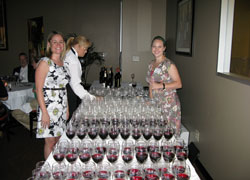 1. Tweets Say: Texas can be proud of its wines.
1. Tweets Say: Texas can be proud of its wines.
The event started with a vintner dinner on Friday evening for the conference guests, most of which were writers from out of state that had not tasted Texas wines previously. By and large the reaction to the Texas wines served at dinner can be summed up by the following Tweet: “Eating dinner at Drink Local Wine Conference. Surprised and impressed by the wine. Very promising weekend ahead.” The wines at dinner were from Brennan Vineyards, Llano Estacado, McPherson Cellars and Flat Creek Estate and not a bad one in the bunch. Later in the evening after the third wine course another tweet said the same thing, but in a little flamboyant manner: “I can say is: HOLY SHIT! They can make wine in Texas!” This came from the lone Californian in the delegation. This became the tagline repeated by many during the weekend’s festivities. So Texans, be proud of your wines. They are good and now of the quality level that needs no apologies. For more participant comment, go to: www.search.twitter.com a search “DLW09” and “Texsom”.
2. Organic wine in Texas?
Yep…Kind off. CapRock Winery (Lubbock, TX – www.caprockwinery.com) made a Viognier that was released earlier this year that was made from organic grapes grown on the Bingham Family Vineyard (www.binghamfamilyvineyards.com) on the Texas High Plains near Lubbock. It is full of rich stone fruit and honeysuckle qualities, But alas, Texas is a difficult place and this year Lubbock area got much of the rain destine (and much needed) in other parts of the state. The result was more bugs than normal and the Bingham’s have to venture away from organic and spray their vineyard with insecticide. While the supply lasts at CapRock, we can brag that we have our first wine made from organic grapes. However, this year’s vintage with be non-organic.
3. What’s new in Texas wines?
The first session of the DrinkLocalWine.com conference addressed this issue head on. From a tweet, here is a list that was repeated by many others…”Biggest changes in past ten years – Susan Coombs TX Ag Comm; winery sales in dry TX counties; Qlty improvement; [Growing] what grows best”. Susan Coombs took the proverbial bull by the horns. During her tenure at Ag commissioner, many laws were changed none bigger than the change to the state constitution that allowed wineries to both operate and sell Texas wine in the dry areas (regions with no alcohol sales) in Texas. This is still most of rural Texas Second, major change is the improvement in quality. More wineries are making good palatable wine (although some wineries in highly visible still have not gotten utilized resources and gotten on a quality program) – (See www.gotexanwine.org and http://winegrapes.tamu.edu for more details). However, none were in the group that elected to participate in the tastes-off. Part of the Texas quality is to grow what grows best in Texas. It was mentioned that some of the biggest initial problems in Texas were caused by out of state consultants (from CA) that promoted field and winery practices and varietals that just were not good for Texas wine. Hopefully we are past this, now.
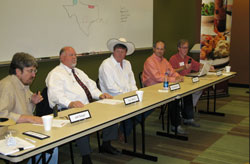 4. What does “For for sale in Texas Only” on the bottle mean?
4. What does “For for sale in Texas Only” on the bottle mean?
Most consumers do not know that if their bottle of wine from a Texas winery says “For sale in Texas Only” on the back label, it is most likely NOT made with Texas wine. Sounds strange, but true. At Texsom, I have tasted a Tempranillo from a Texas winery that won a gold medal in a major California wine competition earlier this year. I asked to look at the bottle and sure enough, the back label said “For Sale in Texas Only”. A taste proved that it was a very good wine; but based on my palate, I would say that it was not made from Texas grapes. I was able to catch Guy Stout (one of our Texas Master Sommeliers) and gave him a taste. Guy concurred with my conclusion and said. “Maybe it’s up to 50 percent Texas, but this is definitely not Texas wine, the aroma and flavor profiles are not right.” Greg Bruni, VP and Executive Winemaker at Llano Estacado summed it up best and most succinctly when he said, “Texas makes the best Texas wine in the world!”
5. If not Cabernet or Chardonnay, then what?
The second session in the DrinkLocalWine.com conference was covered what the promising Texas varietals. The panel included Texas growers and winemakers and even a Texas master Sommelier. No one seemed to balk with the answers. Long time Texas High Plains grower, Neal Newsom (www.newsomvineyards.com/vineyard.htm), said “I can grow very good Cabernet and these grapes have produced awards wining wines. But frankly, growing Cabernet is very hard work. In my vineyard, Tempranillo and Malbec are doing exceptionally well even after this year’s late spring 21 degree weather in March.” Recommended red varietals for Texas that are showing promise cited in the sessions were Tempranillo, Malbec, Sangiovese, Grenache, Syrah and Mourvedre. The number of white wine varietals for Texas mentioned was markedly lower, but everyone seemed to agree that Viognier and from Texas was exceptional and may be presently giving us some of our best Texas wine. Muscat Canelli is another good grape for Texas that makes interestingly aromatic wine in dry, off-dry and sweet styles. Other new varietals to watch in Texas were Dolcetto (red) and Vermentino (white), but Italian variatals. The bottom line was that while most people call Texas a warm grape growing region, grapes in Texas actually are having more problems with late spring freezes. So, the grapes that will do well in Texas over the long haul will be varietals that can handle both the heat and the cold. This is a hard mix that and both new and established growers should be altered to these requirements when they assess increased acreage.
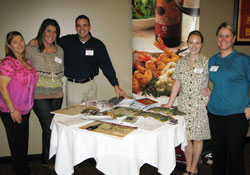 6. Need more Texas grapes.
6. Need more Texas grapes.
During a session that addressed Texas wines and why we do not normally ship out of state, as this would be necessary before the wine community in general would take Texas wine seriously. I had to contribute my two cents as this is one of my commonly stated problems in Texas. I said, “You can do the math. Texas is 5th in wine production and 4th in wine consumption in the USA. There are now over 180 wineries, but we have only 4000 acres of Texas grapes.” We need more grapes grown in Texas before we can sustain an “export model” for Texas wines like other major wine producing states and regions. One panelist mentioned that Texas could use 10,000 acres of wine grapes to sustain its industry. People have asked me if I was planning to grow grapes. Texas does not need me or people like me to get from 4,000 to 10,000 acres of grapes. It needs Texas farmers to diversify to include wine grapes on their less fertile acreage. These are people that know how to grow things and in a big way. They can quickly scale up from 5 to 20 to 50 and 100 acres and more. This is what will make a dent in our deficit in Texas grapes. And, when this happens, the issues with ‘For Sale in Texas Only” should also go away as well.
7. Need more Texas Farm to Table Menus with Texas Wine.
Texas restaurateurs have realized that Texas sells. However, most do not include Texas wines. They present Texas grown foods with wines from California, Chile, Australia and French (to name but a few). This seems strange. Why does it happen? The word from the Sommeliers at Texsom and the DrinkLocalWine.com conference was the most restaurateurs and even Sommeliers have not taken the time to find out about Texas wines. Generally, their wine distributors do not promote them mainly due to their fear that they will not sell. I have been around salesmen to know that they will sell what they know and feel comfortable selling. It is a real chicken-or-the-egg scenario. The other part of the problem is that with limited acreage and wine production in Texas, it is hard for many wineries to sustain a major restaurant account. Smaller family run restaurants have more readily accepted Texas wines and they are a good fit. Farmer-to-table menus could also be a good fit for Texas wines as well. They promote local flavor, character of the foods and can also show the local terroir of Texas wines. A good example of a successful Texas farm-to-table menu that features Texas wines is at Chef Monica Pope’s restaurant T’afia in Houston (http://www.tafia.com/monica_center.html). However, Chef Pope recently got whacked by a wine blogger because who said that Chef Pope was doing a disservice to her farm-to-table menu by featuring Texas wine. [By the way, this blogger did not take the time to attend the events in Dallas last weekend]. It is incredibly shallow not to understand the concept of bringing ALL elements of local terroir to the table, including the wine. One way Texas Sommeliers are getting more comfortable with Texas wines is shown in the following link – Texas Two-Sip blind tastings of Texas wines with Sommeliers (https://vintagetexas.com/?p=663)
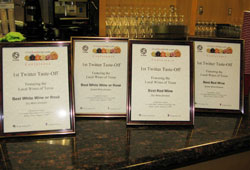 8. Still Lots of Surprises to be Had.
8. Still Lots of Surprises to be Had.
The Texas Twitter Taste-Off was a frenetic event and wild ride held last Saturday at the Condon Bleu Institute in Dallas in conjunction with the DrinkLocalWine Conference. I travel the state of Texas and taste a lot of Texas wines. During my tasting tour around the room during the taste-off I found some excellent Texas wines from wineries with which I had no previous encounters. Two that come to mind are Tara Vineyards (Athens, TX – www.tarawinery.com) and Times Ten Cellars (Dallas, TX – www.timestencellars.com). Tara Vineyard poured flavor-filled sweet and dry versions of wine made from a Texas French-American hybrid grape called Blanc du Bois. Times Ten Cellars is a new winery that has struggled to get Texas grapes, but they hit a home run with their two inky dry red wines: Vino de Tierra Alta, Cathedral Mountain Vineyard and Vino de Piedra, Cathedral Mountain Vineyard (both from the Davis Mountains AVA in Texas. Equally surprising was the sweep of the dry red wine awards (Gold and Silver Awards) in the Texas Twitter Taste-Off by Inwood Estate Vineyards (www.inwoodwines.com) for their Magellan (Bordeaux blend w/Tempranillo) and Tempranillo Cabernet blend.
9. Sweet Wine can be a Serious Wine.
By far, the top vote getter in the Texas Twitter Taste-Off was the Madeira Blanc du Bois made and presented by Haak Vineyards and Winery (Santa Fe, TX – www.haakwine.com). At 18% alcohol and 10% residual sugar, and $39.95 per bottle, this wine is substantial on all accounts. It first spent 24 months in new American oak and then was placed in neutral oak barrels and aged in the classic Madeira method in an Estufa (heated cellar) for 6 more months prior to bottling. This wine was reminiscent of dried apricots and peaches fused with almond and vanilla. It had the richness of honey and the zing of a tree ripened stone apricot. Raymond Haak at Haak Vineyards has found more ways to work with Blanc du Bois grape than anyone and has the awards to show that this versatile grape can make good wine in many styles and, best of all, can be grown nearly anywhere in the state – including the Gulf Coast region which can’t grow the classic vinifera grapes.
10. Who is Robert Parker Anyway?
In reflection, my experiences over the past year include two Wine Bloggers Conferences (2008 which I attended live in Sonoma and 2009 that I monitored via Twitter feeds and live and after-the-fact blogs), over a year of personal wine blogging and most recently organizing the Texas Twitter Taste-Off. This activity has proven to me that the wine world has gone virtual. I can “attend” nearly any public or private tasting anywhere in the world without leaving the comfort of my home base. I am getting information from people that I am starting to know through their twitter and blog postings that have access to the best wines, niche wines and emerging wines from all over the world. Many of these people are what would be called Millennials. This somewhat elusive group is defined in various ways – Generation Y, also known as The Millennial Generation or Echo Boomers – with no precise dates for when they started and ended but usually taken as having birth dates from the mid 1970s to early 1990s inclusive. These people live by experience, not by recommendation. When it comes to wine, they experience and share their comments. Most do not even know who Robert Parker (www.erobertparker.com) is let alone follow his every word to buy, hold and drink. They trust their senses, their personal network, of friends and relationships with others they have developed through the real and virtual world that now spans the globe. Most of the wine the younger generation is drinking comes through referrals from their peers through these channels and thus bypasses the historical gatekeepers (Wine Spectator, Wine Enthusiast and Mr. Parker). Texas wineries need to embrace and become familiar with the new, alternative and direct media (which include blogs and Twitter) to reach these people who are ready and willing to join in on the future of the Texas wine experience.
More about last weekends festivities can be found at:
https://vintagetexas.com/?p=1083
https://vintagetexas.com/?p=1076
T0 find it all just Google search Texas+wine or Local+Wine+Texas+(Conference or Taste-Off), or Search Twitter using #TXwine, #DLW09 or #Texsom. You’re connected to the Internet, now its up to you to use it.
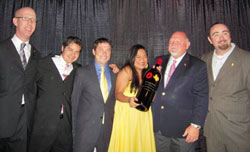 Last but not Least….
Last but not Least….
The 2009 Texas Sommelier Conference took place at the Four Seasons Resort & Club in Las Colinas, Twenty-one Texas sommeliers competed for Texas’ Best Sommelier. At the Monday night Grand Tasting, the winners were announced. June-Ann Rodil of Uchi in Austin won. Anibal Calcagno (Brenner’s Steakhouse in Houston) took 2nd, and John Honefenger (Tony’s in Houston) took third. (In photo: James Tidwell, Devon Broglie, Craig Collins, June-Anne Rodil, Guy Stout, Drew Hendricks)

Very incisive and insightful, Russ.
You deserve a lot of the credit for this first of its kind event. Let us know where the next DLW event will b.
Here is a comment sent to me from Facebook by Benjamin CALAIS, Winemaker at CALAIS Winery (www.calaiswinery.com):
Hi Russ,
I was reading your last post about the Drink local Wine conference about Caprock’s Organic wine from Cliff Bingham’s organic grapes (See http://www.binghamfamilyvineyards.com).
Since we are getting some grapes from Cliff this year I searched the subject to get my labels approved and here is my understanding of US laws on organic wine:
– If grapes are organic then we can label “made from organically grown grapes”
– In order to label organic grapes, the grapes needs to be farmed organically and the winery needs to be certified organic by USDA.
– Another requirement for organic wine is NO ADDITION OF SULFITE requirement, only sulfite produced by the yeast during fermentation are authorized (not sure how to test which is which …)
The no addition of sulfite is a pretty difficult requirement for a winery ( it gets dangerous to do a cold soak prior fermentation, white wines that we produce with no ML can do it in bottles …)
Just thought I would share my findings with you.
Thanks for all the good work showcasing good texas wines.
Benjamin CALAIS, Winemaker CALAIS Winery
I had the privilege of serving on one of the panels and have to thank Russ as well as Jeff, Dave, GO TEXAN and the other organizers for a great event. There were many lessons to be learned from the event and I’m glad that Russ organized a top 10. Really looking forward to the next conference, wherever it may be.
I would like to know what others attendees and participants think about other “lessons learned from DrinkLocalWine, Taste-Off or Texsom events.
Russ
A lesson from the DrinkLocalWine learned was that it is hard to find TX wines in TX cities, and the problem is widespread. I know I do not see many TX wines when I shop in Dallas. I would like to be able to obtain more TX wine. Yes, they can ship to me, but I would love to be able to find it when I shop.
I loved the conference and found it to be very informative and the taste-off was great. I want to get some of those wines.
Another thing learned is how supportive the Texas Department of Agriculture is toward the wine industry and grape growers. Other states should take Texas’s lead.
I agree with your assessment. In Texas, we hardly think of our government as being progressive. But, being an historically agricultural state, the Texas Department of Agriculture is a powerful group. Once we got on the state on board that wine actualy was an agricultural product the TDA took over and has made great strides in promotion, education and field implementation in support of the Texas wine industry.
But, recall one thing that was said at the DLW conference, the wineries stepped up and agreed to tax themselves and directed this money to fund the TDA effort. This step is just as big as what the TDA has done.
Wineries in other states need to step up like they did here in Texas to create the funding and the mechanism to utilize it – remember Case is King!
I call this the Washington State Model – they did this 12-20 years ago and see what dividends (and good wine) it has produced.
Russ
Rus….great report, exciting news, I believe Texas is on the verge of being recognized for its value in the wine-making world. Thanks to you and the participants at the event for raising an even greater awareness. I had to laugh out loud about your comment that the so-called critic of Chef Pope didn’t show for the event. Surprised? Not me. Wish I could have been there but I was in a class in Grayson learning how to grow grapes hoping to solve #6 in your blog.
The hospitality for this event was as BIG as Texas. Texas is now where California was in the early 1970’s, right on the verge of an explosion in the Wine Industry. Napa has four times the number of wineries than Texas with Napa being the #3 wine-producing county in California. Anyone care to guess who #1 and #2 wine-producing counties in California.
One lesson to learn from California. The fraternal spirit in California became a range war when the different AVA’s got set up, pitting wineries against each other. Let’s not let that happen in Texas.
I would have to guess that Sonoma wold be one of the other major CA wine counties.
It was good to finally meet you rather than just reading your column in the paper.
Russ
Great post Russ! I’m just glad to be a part of it. I somehow managed to end up in a lot of the photos without even trying. LOL.
Thanks.
It must be your beauty that attracts the camera 🙂
Great to meet you in Dallas and hope that we can meet-up again in the future either at your place (CA) or mine (TX) or even someoneelse’s place (CO, VA, AZ, etc.).
Russ
Check this out:
Joe and Ann Pollack, St. Louis’ most experienced food writers came to Texas for this event. See what he has to say about Texas wines:
This Week’s Wine, August 25, 2009
In my sports writing days, I traveled to Texas a lot, covering college and professional football, which is the state religion of Texas. Basically, Texas was legally dry in those days, but people who could get into the Dallas Press Club could get a drink. So could members of countless other clubs, usually with a temporary membership fee of a dollar. Whiskey was extra, but many people carried brown bags with open bottles, paying several bucks for a glass of ice and a mixer.
Wine? What’s wine? Oh, that’s the stuff you drink in church. . . .
Try a Falstaff, or a Pearl, or a Dixie.
Times certainly change. A couple of weeks ago, I went to Dallas for a weekend of wine – Texas wine – and a lot of it was excellent. I’m part of a group of wine writers who think that California is not the be-all and end-all, though we believe a lot of excellent wine is made out there, and a couple of dozen of us were on hand, representing newspapers, magazines, television stations and blog sites from Virginia, Maryland, California, Georgia, Colorado and the District of Columbia, in addition to Texas and Missouri.
More at: http://stlouiseats.typepad.com/st_louis_eats_and_drinks_/2009/08/this-weeks-wine-august-25-2009.html
Check out Drinklocalwine.com conference and Virginia twitter taste-off at: vintagetexas.com/blog/?p=1592